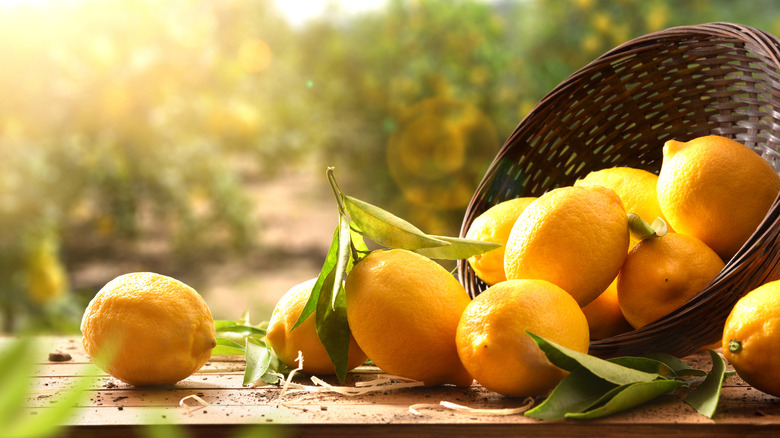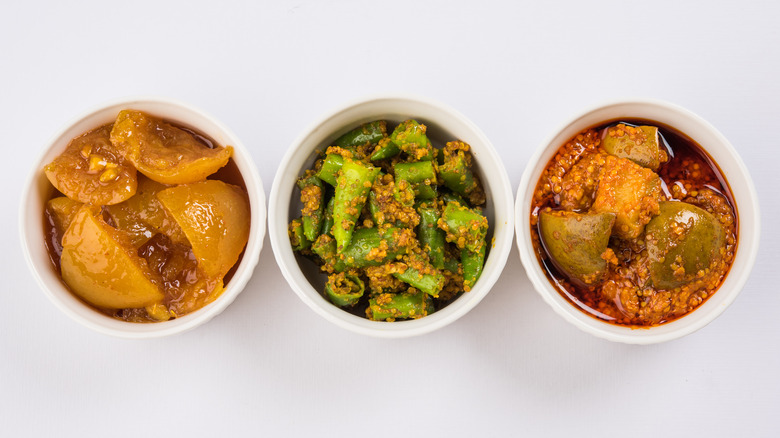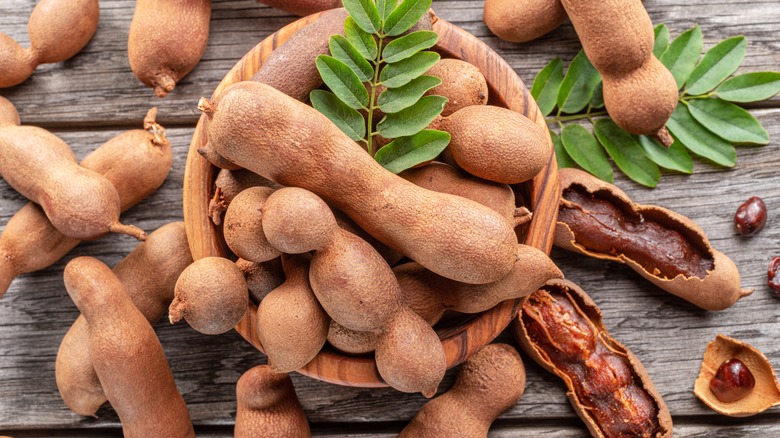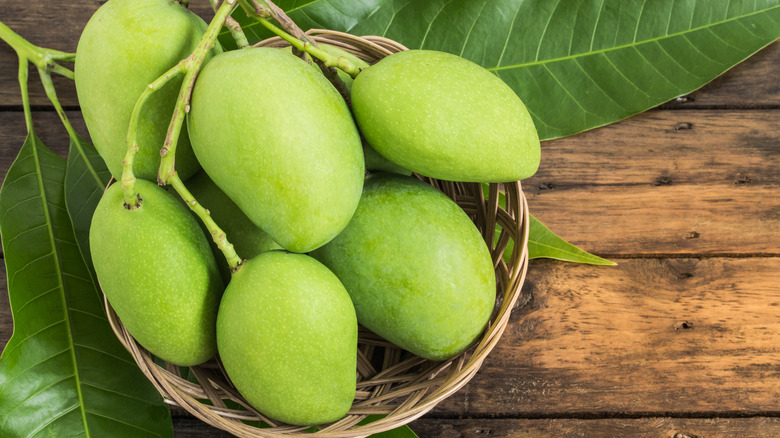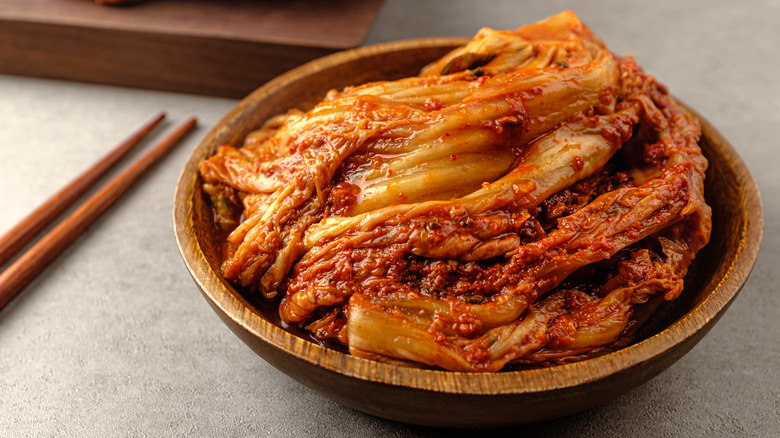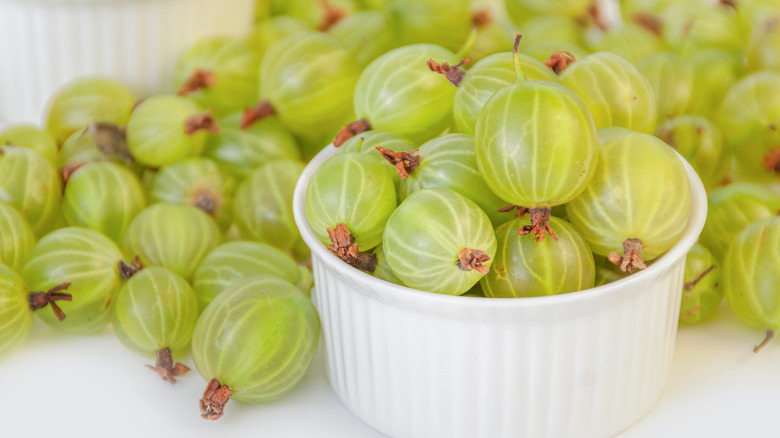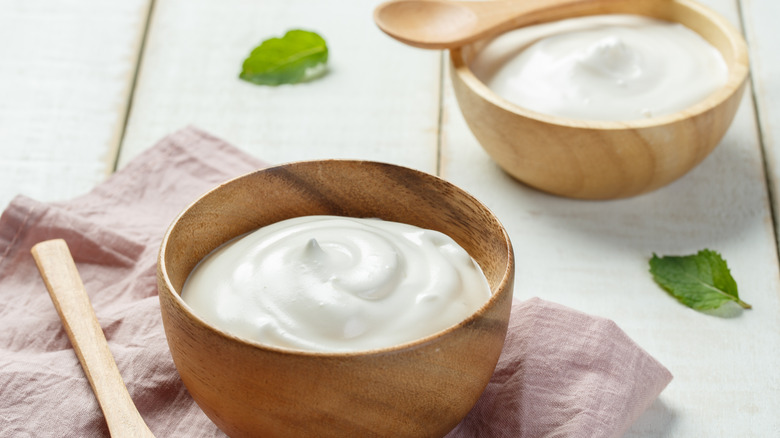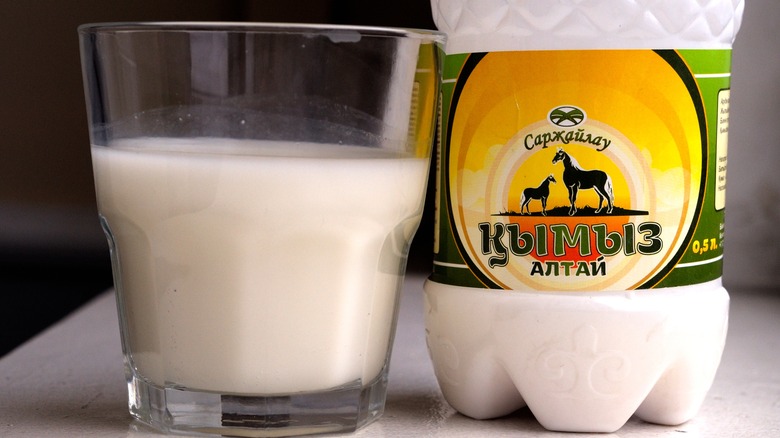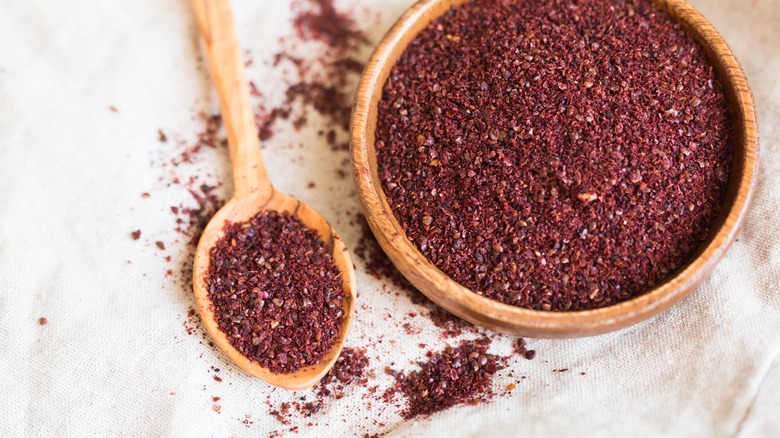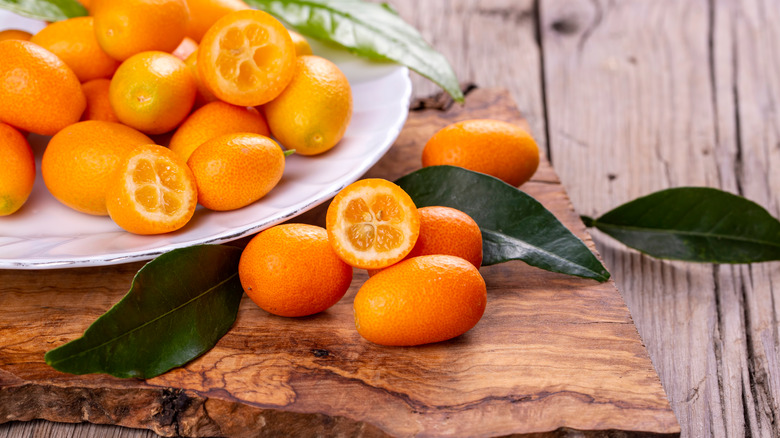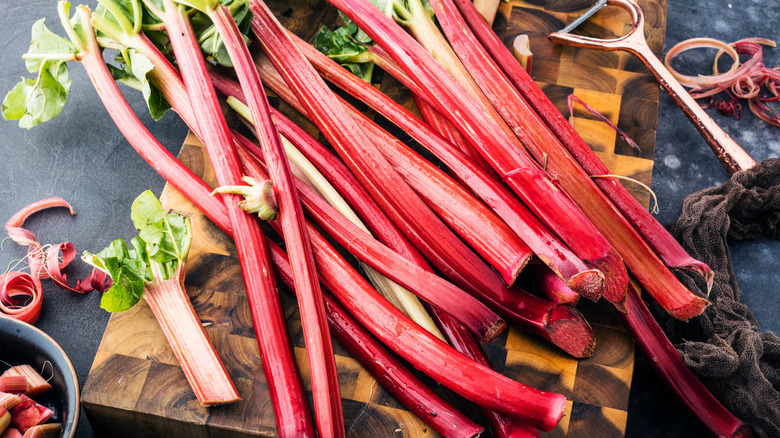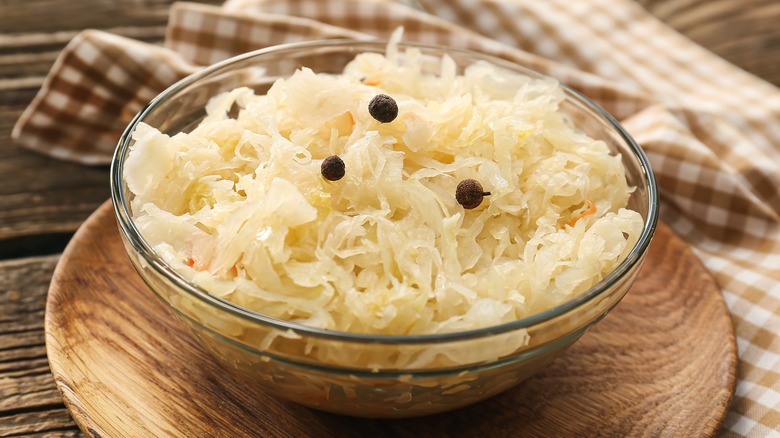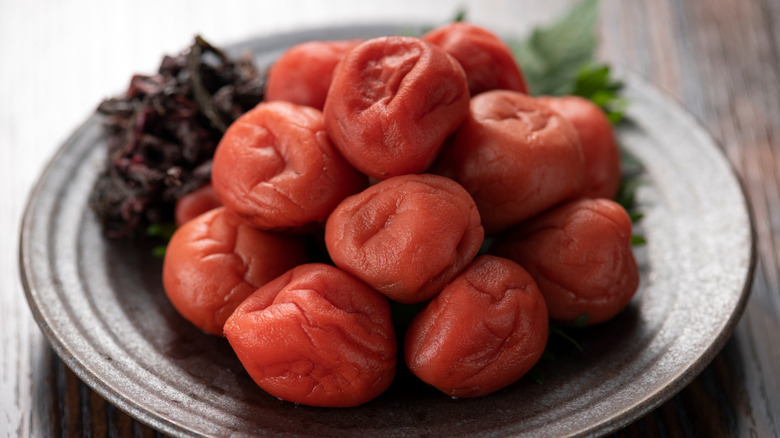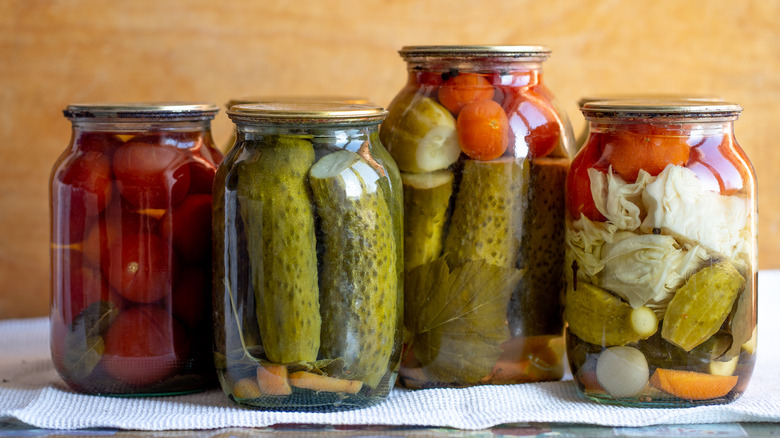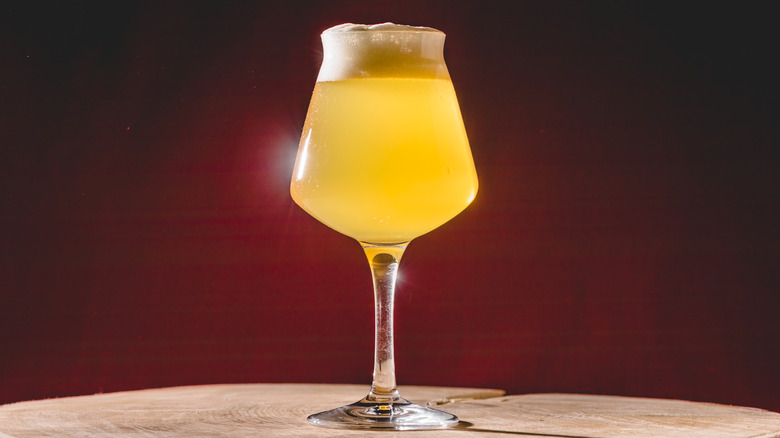The Most Sour Foods In The World
Eating sour food undoubtedly provokes an extremely visceral reaction. And while you may have become immune to it by overzealously consuming the stuff, all you have to do is feed a lemon to a baby to see the effect. Their mouth will pucker and they'll most likely make some faces to express their uncertainty about the whole experience.
Yet, more often than not, when we bite into something sour we want more. Whether it's a matter of actually enjoying the mildly uncomfortable moment or simply a response to involuntary salivation, sour foods have a certain appeal. In the natural world, the most likely candidates for sour flavors are fruits. However, around the world humans have taken foods and allowed them to undergo processes like fermentation, ultimately producing a sour result (via Eat Cultured). That's dedication!
You might enjoy adding a sour element to dishes to make them pop, or perhaps you have fond memories of trying to eat the sourest candies available. Whatever the source of your cravings, find out whether you've tried the top sour foods from around the world.
Citrus fruit
Citrus fruits might very well be one of your first experiences of eating sour foods. According to a study published in Nature Communications in 2019, their genetic profile contains a higher proportion of hydrogen ions, which are perceived by the mouth as acidic or sour. Britannica notes that lemons can easily contain 5% citric acid in their juice, yet we still use them in countless recipes from desserts and drinks to garnishes.
The New York Times argues that we're physiologically primed to desire this taste because it ensures sufficient vitamin C consumption. Indeed, it's well documented that lemons and oranges saved countless sailors from succumbing to scurvy during long sea voyages (via BBC). Nowadays there are more than 100 varieties of citrus fruits, according to Leafy Place. They're originally native to Southeast Asia, per a 2018 study in Nature. With ranging levels of sourness and taste, each is unique.
Citrus is enjoyed in countless ways across the globe. Ceviche is a common South American dish from Peru, made by marinating raw fish in citrus juice and seasoning, according to National Geographic. The acid works to firm up the proteins, resulting in a texture similar to cooked fish. Meanwhile, in the Phillippines, the small citrus fruit calamansi is used in a number of recipes, marinades, and to make a rendition of lemonade to quench thirst (via Manila Sun). In the Middle East, dried Persian limes are an irreplaceable element to season plenty of Iranian foods (via Bon Appétit).
Indian pickle
You've surely tasted cucumber pickles before, but Indian pickle is an entire category in itself. Also called achaar, MasterClass indicates that the ubiquitous condiment adds an acidic zing to any dish, providing the optimal contrast of flavors. While it is commonly served along with a meal, it can also stand alone as a side plate. These versatile serving options might explain why there are hundreds of types of Indian pickles, made with an infinite combination of ingredients.
Whether it's regional distinctions such as the use of mustard oil in the north and sesame oil in the south, per MasterClass, or individual differences between households, you're guaranteed to taste an achaar that you like. Some classic bases are lime, mango, gooseberry, and carrot. Meanwhile, typical spices include fenugreek, chilis, mustard seeds, turmeric, garlic, and ginger (via NDTV Food).
Often, heavily seasoned fruits or vegetables (or even prawns) sit in the sun to ferment for a number of days, producing the recognizable tanginess of the sour condiment. Other preserving methods are also used, and the pickle might ferment in the refrigerator or be par-boiled (via Gharana). Although the process usually produces an acidic taste, some types of Indian pickles are seasoned with greater amounts of chili pepper or sugar, modifying the flavor profile.
Tamarind
While the fruit itself isn't a supermarket staple in the U.S., the sour flavors of tamarind are increasingly widespread. The tree is native to tropical countries in Africa, though Britannica indicates that it is now found across India, Central America, and Mexico. The fruit is long and contains pods and an edible pulp on the inside (via Spices Board India). Although tamarind is undeniably sour thanks to the high levels of tartaric acid (via MasterClass), it also has a pleasant sweetness to balance out the mouth-puckering sensation. Also, keep in mind that since it is a fruit, it goes through stages of ripeness that are reflected in the acidity.
While you can purchase — or better yet, pick — the fresh fruit, the pulp is commonly sold as a block of paste to be used in various recipes. Another option is to use tamarind powder to flavor your dish without affecting the texture. BBC Good Food highlights the fruit's use in curries, chutneys, and bean dishes, where it adds a punch of flavor and acid that brightens up any meal. If you want to try it straight, tamarind juice and soda are obvious choices. Tamarind's acidity makes it an excellent candidate in a marinade since it will simultaneously add flavor and tenderize the meat, MasterClass points out.
Green mango
Although ripe mangoes are among the sweetest fruits, green mangoes take a distinctly different turn on the flavor spectrum. Sour and tangy, these are definitely not going to satisfy your sweet tooth. NDTV Food explains that green mangoes are common in the spring shortly prior to mango season since they are picked early to preserve the tart flavor.
The outlet notes that they are commonly used in fresh Thai salads, as well as in plenty of Indian recipes. Whether they are pickled, juiced, used in a chutney, or added to a curry for a zingy bite, green mangoes are a star in the kitchen.
If you can't get your hands on the fresh fruit, green mango powder, aka amchur, is a magical seasoning. Fine Dining Lovers explains that the fruit is dried in the sun and then ground into a powder, retaining its tangy citrus properties. As a powder, this ingredient can be incorporated into marinades and spice mixes, or simply stirred straight into a dish. Plus, you'll have the benefit of retaining your recipe's consistency while adding plenty of flavor at any time of the year.
Kimchi
By now, whether you've traveled to Korea or not, you've probably had the pleasure (albeit acquired) of enjoying kimchi with a meal. A combination of shredded vegetables (often cabbage), garlic, ginger, chili, fish sauce, and salt typically form the foundation, but kimchi comes in many styles and can be used in many ways. Once the ingredients are mixed together, they begin to pickle and ferment as novel flavors are produced.
The range of flavors varies depending on the components; the more chili pepper you add the spicier it will be. As well, how long you leave the kimchi fermenting affects the result. Over time, Healthline explains that the flavor becomes progressively sourer, evoking the often used descriptor funky to label the taste.
As BBC reports, there are countless bacteria present in kimchi, and due to their live nature, they continue to fluctuate over time. Notably, the fermentation process produces lactic acid bacteria. According to a 2016 study published in Frontiers in Microbiology, this type of bacteria has numerous beneficial effects including anti-inflammatory, antioxidant, anticancer, and probiotic properties. This lends some credence to the possible health benefits of eating sour foods in general.
Gooseberries
Among the several varieties of gooseberries, some are native to North America whereas others originated in Europe (via Britannica). The spherical fruit has a range of flavors depending on the specific type and maturity. The green ones are characteristically tart and they become sweeter as they ripen and the color turns to purple, according to Allrecipes.
If you're the type of person who seeks out the sourest candy available, then you'll love munching on juicy green gooseberries on their own. However, they are often incorporated into recipes in order to balance out their acidity. There's no shortage of ways to use the fruit whether you leave it raw or cook it.
Gooseberries work well in a pie filling, cooked into jam or chutney, or pickled or canned for long-term preservation. Alternatively, use them to contrast a savory sauce paired with meat or to give a salad an extra tangy bite. BBC Good Food even recommends using them to make syrup since the fruit's sour qualities could benefit from a generous dose of sugar.
Sour yogurt
You might be more accustomed to eating sweet (preferably frozen) yogurt, but in many cuisines, sour yogurt takes center stage. Before you turn your nose up at the idea, hear us out. For starters, there's a difference between a tangy flavor and yogurt that has fully gone off. As long as there's no mold, discoloration, or noticeably unpleasant smells then it should be fine to consume.
Since yogurt is the product of fermentation, it follows that lactic acid bacteria are produced in the process, and continue to develop if live cultures are present (via Food Republic). These bacteria characteristically lend a sour flavor to food, turning your yogurt from bland to zippy. In Indian cooking, sour curd is the regional style of yogurt, typically used in countless dishes, according to Indian Healthy Recipes. The fermented properties provide a kick of flavor to any dish, making it a staple.
Time of India notes that it can be used to make idli (steamed rice cakes), cheela (flatbread made with chickpea and other pulse flours), and dhokla (spongy chickpea flour and sour curd cake). Turkish and Iranian cuisines serve up a sour yogurt-based drink called ayran, which is perfect as a complement to a warm flavorful meal or served alone as a refreshment (via Wander Cooks).
Kumis
Kumis might not be the most accessible sour food around, but it might be one of the most unique. Made from fermented raw unpasteurized mare's milk, this alcoholic beverage is the last drink you'd find in your local bar. However, nomadic cultures in Central Asia have been sipping on the stuff for millennia, according to Atlas Obscura. The outlet notes that the milk is churned until it becomes acidic and the natural yeast initiates alcoholic carbonation.
While the alcohol effect is secondary, more importantly, the process was used in order to preserve the milk and make it more digestible. Amongst regional nomadic groups, even babies drink kumis, although Atlas Obscura highlights that it's typically lower in alcohol than the adult version of the beverage. The alcohol level is generally quite low and kumis is enjoyed for its perceived health properties — though a light buzz might in part be responsible for these (via Slow Food).
Sumac
This Middle Eastern spice is an all-around star in the kitchen. Its deep red color might make it look like chili powder but sumac has a decidedly tart and citrusy flavor which is why it's one of Alton Brown's secret ingredients to punch up flavor in starchy foods. MasterClass describes two of the main types (there are around 150 in total): fragrant, aka lemon, and smooth sumac. The plant itself produces berries that are normally dried and crushed into a coarse powder for cooking. Many people compare it to lemons since the flavor and punch of acidity are very similar. In fact, Before lemons were available in Europe, sumac was used instead and praised for its healthy properties (via Farmer's Almanac).
Whether you use it as a marinade or meat rub at the start of a recipe or sprinkle it over vegetables or dips as a finishing garnish, the zingy effect makes for a pleasant bite. Plus, the striking burgundy hue adds plenty of visual appeal to any dish. Sumac is a quintessential feature of countless Middle Eastern recipes, and it makes a notable appearance in a regional spice blend known as za'atar, along with assorted herbs like thyme, marjoram, oregano, and sesame seeds (via Bon Appétit).
Kumquats
Although kumquats look like tiny oblong clementines, they have a distinct flavor that makes them a nice alternative. The orange fruits originate from eastern Asia and they are particularly common in China, according to Britannica. However, nowadays you are just as likely to find them in Florida or California, FoodPrint notes. The outlet explains that although they are part of the Rutaceae family along with similar-looking citrus fruits, these miniature versions are classified as a different genus.
Kumquats take center stage at the Chinese Lunar New Year, as they are said to bring luck and abundance (via FoodPrint). If you're planning to eat them instead of displaying them as a charm, it's worth noting that you can actually consume the peel as well as the juicy interior. In fact, the peel is typically slightly sweeter than the tart pulp. Even better, Healthline points out that the peel contains high levels of antioxidants from the oils. Kumquats can be consumed in various forms, whether raw, jellied, candied, or preserved in other ways (via Britannica). Alternatively, their bright acidity is a great contrast to savory dishes like poultry, salmon, cheese, or a green salad.
Rhubarb
If you like visiting your local farmers market, then chances are you've come across seasonal supplies of rhubarb from early spring to mid-summer (via Bon Appétit). The thick pinkish red stalks are edible but it's important to eliminate the toxic leaves before use. Curiously, the plant is actually a vegetable, which should make you feel less guilty if you suddenly develop an affinity for rhubarb pies.
Biting into a fresh piece of rhubarb will certainly wake up your taste buds with a jolt of acidity, so it is often used in sweet recipes to balance the tart flavor. BBC Good Food recommends pairing the tangy stalks with strawberries or ginger and either roasting, poaching, or stewing it for a softer consistency. Jams, pies, crumbles, and other baked goods are all ways to make good use of rhubarb. However, you don't have to stop at dessert; pair it with savory meat dishes as a sharp contrast to fatty flavors from pork or duck.
Sauerkraut
Whether you're fluent in German or not, you might have an aha moment when you realize that sauerkraut translates to sour cabbage. This classic sausage pairing is another example of fermentation producing tangy flavors, not to mention beneficial effects on digestion thanks to the probiotics (via Healthline). While some people choose to cook sauerkraut, the benefits tend to fade with heat. Given that fermented food contains live bacteria, it requires specific conditions to develop, after which it is best stored in the refrigerator (via Cultures For Health).
The traditional recipe keeps it simple with grated cabbage and salt, allowing the lactic acid bacteria to bring the bulk of the flavor, per Cultures For Health. That's not to say there's no room for experimentation; dill, garlic, cumin, and assorted spices are welcome additions. Also, other variations such as carrots, zucchini, beets, apples, or parsnips are a nice twist. For the tangiest sauerkraut, try making it yourself, or else look for packaged versions that mention live bacteria on the label.
Umeboshi
Ripe plums are distinctly sweet, however, if you were to ferment or pickle the right type, then you would end up with sour plums, aka umeboshi. Fine Dining Lovers describes the Japanese treat, noting that it comes from a specific variety of plums that are similar to apricots. They are either heavily salted or soaked in vinegar and then aged, producing an extremely sour result, Nippon.com explains. The outlet reports that the acidity comes from a large presence of citric acid in the plums, up to three times more than in a lemon.
Although the taste is certainly acquired, it's well worth it for the numerous health benefits. It has traditionally been consumed as a way to boost immunity, eliminate hangovers, or as an energy source for samurai fighters (via Nippon.com). You could try eating umeboshi solo but to increase your chances of actually liking it, you're better off tasting it with rice or together with a meal. Fine Dining Lovers notes that umeboshi paste and vinegar are other ways to showcase the zippy tart flavor in an easy-to-use format.
Pickles
There are plenty of ways to pickle cucumbers and they don't all produce a sour result. Allrecipes distinguishes between pickles that are salted and fermented and those that are brined in vinegar. While you might think that only the latter are sour, we've already established that fermentation creates lactic acid bacteria which leads to tart flavors.
You can increase the level of acidity by leaving the cucumbers to ferment for a longer period, whereas a quick fermentation will produce a milder flavor. Often, fermented pickles are labeled as half-sour or sour to describe the relative level of acidity. Meanwhile, you might also come across sweet pickles which are made with sugar-sweetened brine (via Taste of Home).
Typically, additional seasoning is incorporated into the brine in order to provide balanced flavors. There's plenty of room to experiment with pickling spices and favorites include garlic, dill, peppercorn, mustard seed, coriander seed, celery seed, cloves, and allspice berries. A crunchy pickle is the ideal sour snack for some folks, while others prefer thin slices layered into a sandwich. Making your own pickles is a satisfyingly easy project to whip up at home.
Lambic beer
If you're a fan of crisp lager-style beers or hoppy IPAs, then you might be surprised to see a beer listed here. However, Belgian lambic beer undergoes a wild yeast fermentation which produces a decidedly sour flavor (via Kitchn). Instead of using specific yeasts to highlight select flavors, brewers allow naturally occurring yeasts to take over.
Total Wine explains that some lambic beers are flavored with the addition of fruit. In these instances, the fruit doesn't cause the beer to be sweet but instead, lends some complexity to the taste. Popular add-ins are cherry, raspberry, peach, and blackcurrant. Another type of lambic beer is called gueuze, a sour beer which is made by blending different batches of beer.
According to PourMyBeer, lambics are best served in fluted glass like you might use for Champagne to maximize both the carbonation and the aroma. KegWorks recommends considering food pairings with strong flavors that will benefit from the vinegar-like quality of the beer. While you can sip on it alone, the tartness makes it a great option to pair with rich, creamy, spicy, and sweet foods.
Vinegar
When searching for a sour condiment, vinegar is often the first choice. Britannica explains that the process entails fermenting diluted alcohol to produce acetic acid. Standard white vinegar is the most basic and only requires grain alcohol, however, there are countless styles of vinegar with a range of flavors. Apple cider, red or white wine, Champagne, sherry, balsamic, rice, and malt vinegar are some common examples.
Using vinegar to make a salad dressing is perhaps one of its most common uses, but you would be missing out if you stopped there. Fine Cooking points out that acidity is an excellent meat tenderizer, making vinegar a great component in marinades. Splash it over cooked vegetables to season, or go ahead and make a jar of pickles. Malt vinegar pairs wonderfully with potatoes, and if you're not in the mood to cook, whip out your white distilled vinegar the next time you are cleaning (via Bon Appétit).

